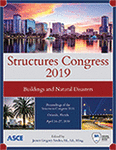Structures Congress 2019
The Behavior of Structural Steel Elements with Damaged Fire Protection Material
Publication: Structures Congress 2019: Buildings and Natural Disasters
ABSTRACT
The rapid spread of high temperature within the steel material results in low fire resistance of steel structures. Various types of methods have been utilized in order to improve the stability and load-bearing capacity of the steel structure during fire incidents. Passive fire protection (PFP) is a popular method used in industrial and residential buildings to protect steel structures against fire. In PFP method a material with high thermal capacity is applied around the steel sections to reduce the heat transfer to structural steel elements. Spray-applied fire protection, concrete encasement, and gypsum boards are different types of PFP methods. Spray-applied fire-resistive materials (SFRM) are commonly applied material to protect steel structures from fire exposure. Some of the widely used SFRMs include CAFCO, Carboline, and Tyfo. SFRM offers many advantages over other types of fire insulation methods such as cost-effectiveness, lightweight, and ease of application. However, the applied fire protection material may be removed due to inappropriate applications and accidents. The direct exposure of the steel material at damaged regions can result in failure of the structural steel elements before the required fire rating of the structure is achieved. The primary goal of this study is to investigate the reduction in the fire resistance of steel beams with damages in the fire protection material. Steel beams protected with fully protected and damaged Tyfo, CAFCO, and Carboline fire protection material were simulated. The fire resistance of different steel beam sections with damaged fire protection has been investigated. The fire protections were designed for one-hour fire rating. Nonlinear thermal and structural finite element models of beams with damaged fire protection were developed. The temperature of various parts of steel beams, as well as mid-span deflection of damaged cases, were tracked and compared with cases with full protection. The results have shown that the fire protection loss can result in significant fire resistance reduction of the beams. This study’s contribution highlights the need for considering the influence of such damages in fire protection material in the design of fireproofing of steel structures.
Get full access to this article
View all available purchase options and get full access to this chapter.
Acknoeledgment
The provided figures in this research article are created by the authors.
REFERENCES
ANSYS® Academic Research, Release 17.1, Help System, Coupled Field Analysis Guide, ANSYS, Inc.
ANSYS® Academic Research, Release 17.1, Help System, Material Reference, ANSYS
ANSYS® Academic Research, Release 17.1.
ASTM E119-16a Standard Test Methods for Fire Tests of Building Construction and Materials (2016). ASTM International, West Conshohocken, PA
Aziz, E.M, Kodur, V.K, Glassman, J.D., Moreyra Garlock, M.E. (2015). “Behavior of steel bridge girders under fire conditions” J. Constr. Steel Res.
EN 1991-1-2 (English) (2002). Eurocode 1: Actions on structures - Part 1-2: General actions - Actions on structures exposed to fire.
EN 1992-1-2 (English) (2004). Eurocode 2: Design of concrete structures -Part 1-2: General rules - Structural fire design.
EN 1993-1-2 (English) (2005). Eurocode 3: Design of steel structures -Part 1-2: General rules -Structural fire design.
Kang, Y., Hadjisophocleous, G. V., Khoo, H. A. (2008) “Effect of Partial loss of Spray-on Protection on the Load Capacity of Steel Beams during a Standard Fire”, Journal of Fire Protection Engineering 18, no. 1 : 5-27.
Kodur, V., Dwaikat, M., Fike, R. (2010). “High temperature properties of steel for fire resistance modeling of structures,” J. Mater. Civ. Eng. 22 (2010) 423–434.
Kodur, V., Shakya, A. M. (2013). “Effect of temperature on thermal properties of spray applied fire resistive materials”, Fire Safety Journal.
Milke, J., Kodur, V., Marrion, C. (2002). “A overview of fire protection in buildings”, World Trade Center Building Performance Study
Milke, J., Ryder, N., Wolin, S. (2012). “Analyses of the Impact of Loss of Spray-Applied Fire Protection on the Fire Resistance of Steel Columns”, Fire safety science- Proceedings of the seventh international symposium, pp. 1025-1036.
NIST Technical Note 1681, (2010). Best practice guidelines for structural fire resistance design of concrete and steel buildings, 199.
Specification for Structural Steel Buildings (2016). Specification for Structural Steel Buildings.
UL Fire-Resistance guideline, (2017). BXUV - Fire Resistance Ratings - ANSI/UL 263 Certified for United States http://productspec.ul.com/document.php?id=BXUV.X738
Information & Authors
Information
Published In
Structures Congress 2019: Buildings and Natural Disasters
Pages: 113 - 123
Editor: James Gregory Soules, McDermott International
ISBN (Online): 978-0-7844-8222-3
Copyright
© 2019 American Society of Civil Engineers.
History
Published online: Apr 22, 2019
Published in print: Apr 22, 2019
Authors
Metrics & Citations
Metrics
Citations
Download citation
If you have the appropriate software installed, you can download article citation data to the citation manager of your choice. Simply select your manager software from the list below and click Download.
